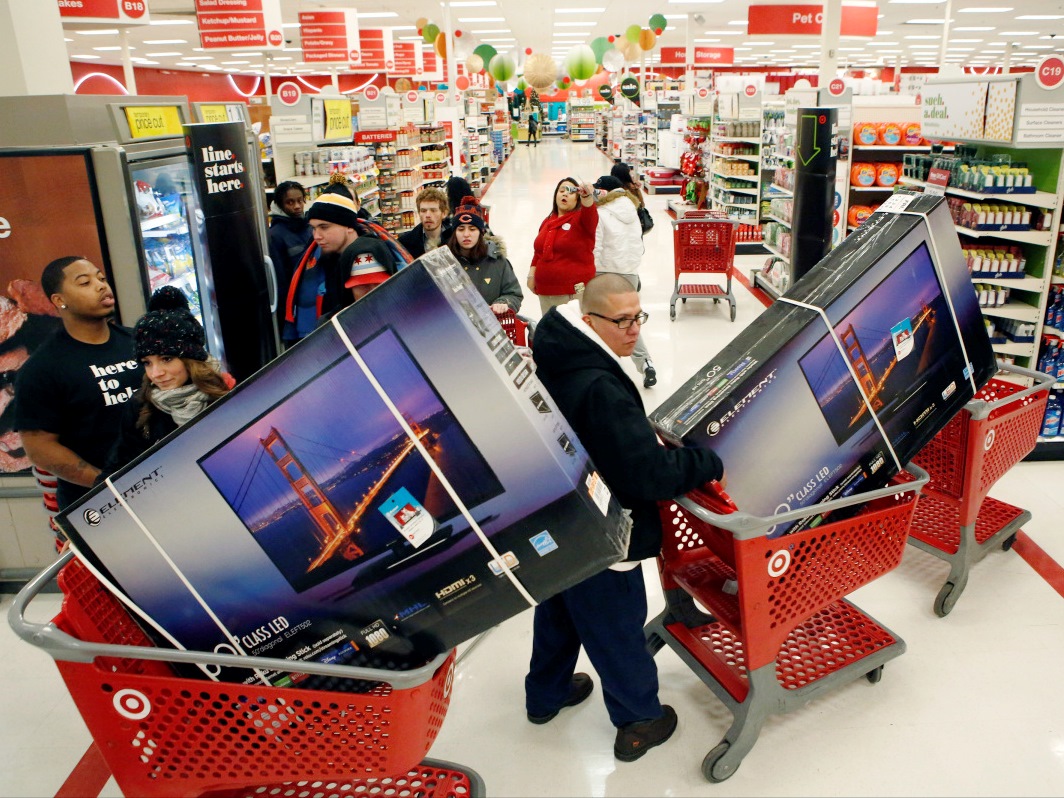
New York — CE once again proved itself a Thanksgiving weekend favorite, while a sharply higher number of consumers used their mobile devices to shop.
But those two bright spots aside, total traffic for the Thanksgiving/Black Friday period was down year over year, as early and prolonged promotions, and fewer discount-dependent customers, took a toll on the weekend tally.
The good news, for CE retailers and vendors, was that 45 percent of all shoppers bought or planned to buy tech products over the weekend, more than in any of the last three years, according to the Consumer Electronics Association (CEA). Only apparel was more popular, appearing in 69 percent of shopping baskets.
“Consumers’ appetite for purchasing technology products during the start of the holiday shopping season hit new highs this Thanksgiving weekend,” said CEA chief economist Shawn DuBravac. “This shows tech is poised to enjoy strong sales throughout the entire 2014 holiday season.”
TVs were the most sought after CE device of the weekend, cited by 37 percent of shoppers, followed by tablets (35 percent), notebook computers (23 percent), videogame consoles (23 percent) and portable wireless speakers (23 percent), CEA said.
However, the trade association also discerned a drop in holiday traffic, with 18 million fewer shoppers in the marketplace between
Thanksgiving Day and Cyber Monday, although those who did shop spent nearly 5 percentage points more this year than last, for an average ticket of $371.
DuBravac believed the traffic decline “is likely due to transactions being pulled forward, as retailers offer more deals in-stores and online earlier in the week than in previous years.”
The National Retail Federation (NRF) similarly cited CE as the second-most popular weekend purchase after apparel, appearing in 34.2 percent of shopping baskets, and specifically pegged the traffic drop at 5.2 percent year over year from Thanksgiving through Sunday.
But unlike CEA, the trade group discovered a concomitant decline of 6.4 percent in average spend, to $380.95 per person.
Observed NRF president/CEO Matthew Shay, “A strengthening economy that changes consumers’ reliance on deep discounts, a highly competitive environment, early promotions and the ability to shop 24/7 online all contributed to the shift witnessed this weekend.”
Shay further believes the weekend results represent a turning point in Black Friday behavior. “We are excited to be witnessing an evolutionary change in holiday shopping by both consumers and retailers, and expect this to trend to continue in the years ahead,” he said.
Retail analyst David Strasser of Janney Capital Markets concurred, particularly for the CE category.
“We believe that 2015 could prove a watershed moment in CE retail, as it appears there is a concerted effort to cut back on promotions around the unprofitable Black Friday/Thanksgiving Weekend,” he observed in a research note. “Vendors, particularly in CE, are trying to change consumer behavior from deep discounting on Black Friday, as the strategy of large discounts does nothing to spur demand but rather drives low/no margin sales for fleeting market share gains, benefiting neither the industry nor retailers.”
Strasser said the trend was most evident in TV, which became symbolic of “profitless prosperity” and is now undergoing “some substantial changes this year.” Specifically, the uniformity of Samsung doorbusters suggests that price controls are in place, he said, while most of the weekend deals were concentrated among minimally-featured, tier-three models.
Perhaps another retail milestone was reached this weekend in mobile. According to retail personalization technology provider Monetate, mobile traffic (phones and tablets combined) accounted for fully 42.5 percent of all online traffic on Black Friday, up 21 percent year over year.
The surge briefly brought BestBuy.com to its knees on Black Friday, as “a concentrated spike in mobile traffic triggered issues” that forced it to shut down for several hours, the retailer said.
Total mobile sales spiked even higher on Saturday, Monetate reported, with smartphone traffic up 52 percent year over year, smartphone revenue up 49 percent, and combined phone and tablet traffic accounting for 44 percent of all online traffic.
“Mobile holiday shopping traffic and sales are increasing dramatically as consumers become more comfortable shopping via mobile,” noted Monetate CEO Lucinda Duncalfe, who also cited increased screen sizes and mobile payment systems.
Total online sales (desktop and mobile) were up 32 percent on Thanksgiving Day to $1 billion and rose 26 percent on Black Friday to $1.5 billion, according to market research firm ComScore.
But those two bright spots aside, total traffic for the Thanksgiving/Black Friday period was down year over year, as early and prolonged promotions, and fewer discount-dependent customers, took a toll on the weekend tally.
The good news, for CE retailers and vendors, was that 45 percent of all shoppers bought or planned to buy tech products over the weekend, more than in any of the last three years, according to the Consumer Electronics Association (CEA). Only apparel was more popular, appearing in 69 percent of shopping baskets.
“Consumers’ appetite for purchasing technology products during the start of the holiday shopping season hit new highs this Thanksgiving weekend,” said CEA chief economist Shawn DuBravac. “This shows tech is poised to enjoy strong sales throughout the entire 2014 holiday season.”
TVs were the most sought after CE device of the weekend, cited by 37 percent of shoppers, followed by tablets (35 percent), notebook computers (23 percent), videogame consoles (23 percent) and portable wireless speakers (23 percent).
However, CEA also discerned a drop in holiday traffic, with 18 million fewer shoppers in the marketplace between
Thanksgiving Day and Cyber Monday, although those who did shop spent nearly 5 percentage points more this year than last, for an average ticket of $371.
DuBravac believed the traffic decline “is likely due to transactions being pulled forward, as retailers offer more deals in-stores and online earlier in the week than in previous years.”
The National Retail Federation (NRF) similarly cited CE as the second-most popular weekend purchase after apparel, appearing in 34.2 percent of shopping baskets, and specifically pegged the traffic drop at 5.2 percent year over year from Thanksgiving through Sunday.
But unlike CEA, the trade group discovered a concomitant decline of 6.4 percent in average spend, to $380.95 per person.
Observed NRF president/CEO Matthew Shay, “A strengthening economy that changes consumers’ reliance on deep discounts, a highly competitive environment, early promotions and the ability to shop 24/7 online all contributed to the shift witnessed this weekend.”
Shay further believes the weekend results represent a turning point in Black Friday behavior. “We are excited to be witnessing an evolutionary change in holiday shopping by both consumers and retailers, and expect this to trend to continue in the years ahead,” he said.
Retail analyst David Strasser of Janney Capital Markets concurred, particularly for the CE category.
“We believe that 2015 could prove a watershed moment in CE retail, as it appears there is a concerted effort to cut back on promotions around the unprofitable Black Friday/Thanksgiving Weekend,” he observed in a research note. “Vendors, particularly in CE, are trying to change consumer behavior from deep discounting on Black Friday, as the strategy of large discounts does nothing to spur demand but rather drives low/no margin sales for fleeting market share gains, benefiting neither the industry nor retailers.”
Strasser said the trend was most evident in TV, which became symbolic of “profitless prosperity” and is now undergoing “some substantial changes this year.” Specifically, the uniformity of Samsung doorbusters suggests that price controls are in place, he said, and that most of the weekend deals were concentrated among opening price point, tier-three models.
Perhaps another retail milestone was reached this weekend in mobile. According to retail personalization technology provider Monetate, mobile traffic (phones and tablets combined) accounted for nearly half (42.5 percent) of all online traffic on Black Friday, up 21 percent year over year.
The surge briefly brought BestBuy.com to its knees on Black Friday, as “a concentrated spike in mobile traffic triggered issues” that forced it to shut down for several hours, the retailer said.
Total mobile sales spiked even higher on Saturday, Monetate reported, with smartphone traffic up 52 percent year over year, smartphone revenue up 49 percent, and combined phone and tablet traffic accounting for 44 percent of all online traffic.
“Mobile holiday shopping traffic and sales are increasing dramatically as consumers become more comfortable shopping via mobile,” noted Monetate CEO Lucinda Duncalfe, who pointed to increased screen sizes and mobile payment systems.
Total online sales (desktop and mobile) were up 32 percent on Thanksgiving Day to a record $1 billion and rose 26 percent on Black Friday to $1.5 billion, according to market research firm ComScore.












